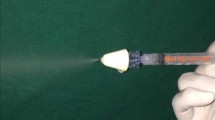Abstract
Background
This study was conducted to evaluate the utility and effectiveness of Intranasal Dexmedetomidine on Sedation status and pain experience of the patients undergoing surgical extraction of impacted third molar.
Materials and Methods
In this double-blind, split mouth study, in 15 patients, evaluations pertaining to classes of third molar impaction was done. Each patient was randomly assigned to receive either intranasal normal saline (placebo group) or intranasal 1.5 µg/kg atomized Dexmedetomidine during the first session. The other regimen was used during the second session. Study was conducted for over a period of 120 min and data for sedation and pain was collected at an interval of 30 min. The collected data was then compared between the two groups within the same patient. Sedation status was assessed by a blinded observer with a modified Observer’s Assessment of Alertness/Sedation (OAA/S) 13 scale (Annexure- B). Pain experience was evaluated by Visual Analog Scale (VAS) (Annexure-B). Clinical evaluation for sedation and pain was done by a blinded observer at 30, 60, 90, and 120 min after administration of the intranasal solution. The values were then tabulated, and compared between two visits.
Results
The mean values of OAA score of Dexmedetomidine group were significantly higher as compared to Placebo group with a ‘p’ value of 0.000. And the mean values of Pain score of Dexmedetomidine group were significantly lower as compared to Placebo group with a ‘p’ value 0.009.
Conclusion
The results of this study clearly indicated that: Intranasally administered Dexmedetomidine was significantly useful and effective to achieve optimal sedation and analgesia during third molar surgery.





Similar content being viewed by others
References
Kazim K, Fahrettin Y, Nebahat G, Cemil C, Murat S, Hasan K (2007) Comparision of Dexmedetomidine and Midazolam for monitored anesthesia care with tramadol via patient controlled analgesia in endoscopic nasal surgery: a prospective, randomized, double blind, clinical study. Curr Ther Res 68(2):69–81
Malamed SF (2003) Sedation: a guide to patient management, 4th edn, Mosby Inc, Missouri, pp 9–12, 23
Merkus P, Ebbens FA, Muller B, Fokkens WJ (2006) The ‘best method’ of topical nasal drug delivery: comparison of seven techniques. Rhinology 44:102–107
Afonso J, Reis F (2012) Dexmedetomidine: Current role in anesthesia and intensive care. Rev Bras Anestesiol 62(1):118–133
Taittonen MT, Kirvela OA, Aantaa R, Kanto JH (1997) Effect of clonidine and dexmedetomidine premedication on perioperative oxygen consumption and haemodynamic state. Br J Anaesth 78:400–406
Guler G, Akin A, Tosun E, Eskitafloglu E, Mizrak A, Boyaci A (2005) Single dose dexmedetomidine attenuates airway and circulatory reflexes during extubation. Acta Anaesthesiol Scand 49:1088–1091
Kaur M, Singh PM (2011) Current role of dexmedetomidine in clinical anesthesia and intensive care. Anesth Essays Res 5:128–133
Warrington SE, Kuhn RJ (2011) Use of intranasal medications in pediatric patients. Pharmacol Update Orthop 34(6):456–459
Talon MD, Woodson LC, Sherwood ER, Aarsland A, McRae L, Benham T (2009) Intranasal dexmedetomidine premedication is comparable with midazolam in burn children undergoing reconstructive surgery. J Burn Care Res 30(4):599–605
Yuen VM, Hui TW, Irwin MG, Yuen MK (2008) A comparison of intranasal dexmedetomidine and oral midazolam for premedication in pediatric anesthesia: a double-blinded randomized controlled trial. Anesth Analg 106:1715–1721
Cheung CW, Ying CL, Chiu WK, Wong GT, Ng KF, Irwin MG (2007) A comparison of dexmedetomidine and midazolam for sedation in third molar surgery. Anaesthesia 62:1132–1138
Nooh N, Sheta SA, Abdullah WA, Abdelhalim AA (2013) Intranasal atomized dexmedetomidine for sedation during third molar extraction. Int J Oral Maxillofac 42:857–862
Author information
Authors and Affiliations
Corresponding author
Ethics declarations
Conflict of interest
Dr. Sujeeth K. Shetty and Dr. Garima declare that they have no conflict of interest.
Ethical Approval
All procedures performed in studies involving human participants were in accordance with the ethical standards of the institution.
Informed Consent
Informed consent was obtained from all individual participants included in the study.
Rights and permissions
About this article
Cite this article
Shetty, S.K., Aggarwal, G. Efficacy of Intranasal Dexmedetomidine for Conscious Sedation in Patients Undergoing Surgical Removal of Impacted Third Molar: A Double-Blind Split Mouth Study. J. Maxillofac. Oral Surg. 15, 512–516 (2016). https://doi.org/10.1007/s12663-016-0889-3
Received:
Accepted:
Published:
Issue Date:
DOI: https://doi.org/10.1007/s12663-016-0889-3




